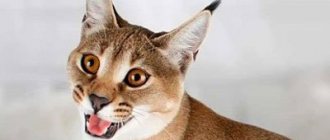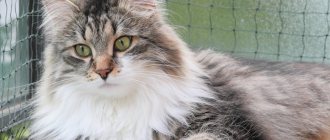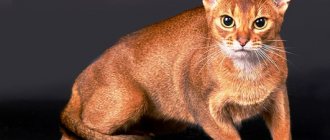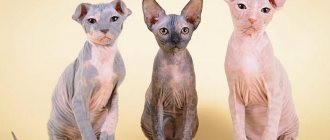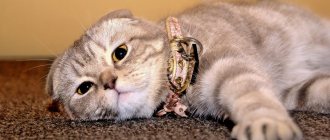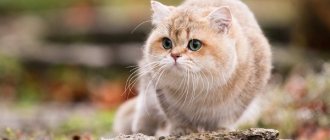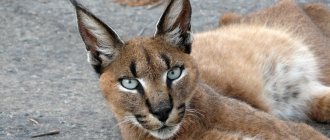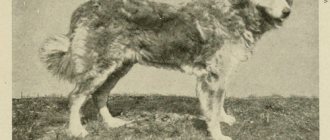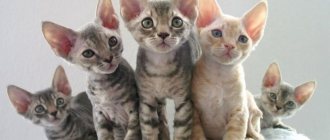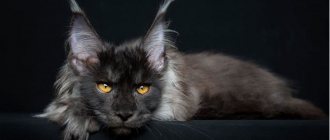Most cat breeds, and more than 70 of them are registered, occurred as a result of random mutations or natural selection in a certain area, but some were bred by purposefully crossing wild cats with domestic relatives. Such breeds are called hybrid. One of the most prominent representatives appeared quite recently, called caracat.
Origin story
The first caracat was born in the Moscow Zoo at the end of the 20th century. One domestic cat was allowed to move freely around the zoo. She probably accidentally wandered into the enclosure of a caracal, and as a result of this meeting, an unusual kitten with a wild caracal color and tufts on her ears was born. The amazing story became public through the media and remained just news for some time. There was no thought about the development of the breed, besides, the born kitten is a boy, and male hybrids are sterile.
Attempts to breed caracats began in 2005 by the American breeder Joy Geisinger, who succeeded in obtaining results in 2007. By crossing a wild caracal and a domestic Abyssinian cat, the offspring of caracats was born. Soon the new hybrid breed was registered as experimental with TICA. But the history of the breed was not continued due to the death of the breeder.
The breed received a revival in Russia. A breeder from Ivanovo, as a result of painstaking work, managed to obtain offspring of caracats. The breed was soon recognized by the ICU.
Modern breeding programs allow the use of not only Abyssinian cats as females, but also cats of any breed suitable in type, color and size, for example, Chausie, Oriental and their crosses.
Health
Caracal babies are born of a standard size and in a normal period for domestic cats - 65-72 days, but by the age of one month they “catch up” with what is inherent in the caracal genes. Kittens grow, develop and gain weight very quickly. The eyes open in the second week from birth.
Caraquet breeders have not yet encountered the infection of hybrids with feline infections. It is likely that the reason is the strong immunity inherited from the caracal. However, the introduction of a comprehensive vaccine against feline viruses and rabies is mandatory and does not lead to negative consequences.
Origin story
The Caraquet cat looks like a real domestic lynx. And all because it is a hybrid of a real wild caracal (steppe lynx) and a domestic cat. The name of the breed comes from two words caracal + cat = caracat. After crossing wild and domestic cats, a unique breed was obtained. Exotic appearance, graceful gait, huge expressive eyes of a wild lynx, and at the same time the docile and friendly character of a domestic cat. It's no wonder this breed has so many fans. You can fall in love with her at first sight!
The breed appeared quite recently - only 30 years ago - and it happened by accident. In 1998, at the Moscow Zoo, a domestic cat snuck into the enclosure of a male caracal (steppe lynx). Zoo staff decided that the lynx would perceive her as prey and the cat would no longer survive. However, everything turned out differently. The cat carried and gave birth to one kitten from a caracal, which looked very similar to a wild lynx and had obvious features of its exotic father: fluffy tufts on the ears, large soft paws and bright eyes with dark rims. After this incident, no such experiments were carried out for several years.
Then, in 2005, in the USA, one felinologist tried to repeat the experience of the Moscow Zoo and crossed an Abyssinian cat with a caracal. As a result, kittens were born, but they could not have offspring. For several years, the American breeder received several individuals of caraquets, and then ceased operations.
It was in Russia that they began to successfully breed caracats. The owner of the Krasnodar nursery “KATALEYA”, Irina Nazarova, has been conducting breeding work since 2007 and achieving the development of the breed. At the moment, this is one of the largest caraquet nurseries in the world. The breeder regularly receives kittens of the F1 and F2 generations and works to improve the breed. She organized the first caraquet exhibition. And yet the breed is rare. In total, there are about 70 individuals of the F1 type and 15 individuals of the F2 type in Russia.
There are several generations of caracats: F1 - has 50% lynx admixture, this is a direct descendant of the caracal and the domestic cat. F1 are the most valuable representatives of the breed, as they have the most pronounced appearance of a wild cat. The physique is large, wild habits appear. F2 - has 25% lynx admixture and is a descendant of cats of the F1 generation and a domestic cat. F3 - 16% of the wild breed genotype, mating of an F2 female with a domestic cat. These cats still have the appearance of a lynx, but not as obvious. The character is calm and soft. F4 - 6% of the wild breed genotype, the result of crossing an F3 female with a domestic cat. These individuals retain only some external features from the lynx, but their character is very calm.
How much does a caraquet kitten cost?
The unique breed is not only the rarest, but the most expensive in the world. A kitten without the right to breed costs about 1,000,000 rubles. To find out more about prices, it is better to contact the breeders directly. One of the requirements when purchasing a caraquet is to maintain further communication, in exchange for which the nursery provides competent advice and assistance in growing.
Every year the breed becomes more and more numerous, and the price of a caraquet kitten is more affordable, this cannot but please exotic lovers and potential buyers.
History, character and description of the Caraquet breed
The caracat was the result of a bold experiment - this exotic cat was descended from a wild caracal cat crossed with domestic breeds. The caracat received the first part of its name from its wild ancestor, and the ending “cat” means “cat” in English. The appearance of such a spectacular pet was thanks to our compatriot from Krasnodar - Irina Nazarova. It was in her nursery that, from 2013 to 2022, two healthy generations of caracal and domestic Bengal cat hybrids were obtained. The new breed is officially registered with the International Cat Association (TICA) and is included in the Unified Cat Register (ICU). Unusual pets are still considered rare - the number of adult individuals in the world is not yet so large. But the unique, bright appearance of caracats has already become the reason for their rapidly growing popularity among lovers of exotic animals. However, not everyone can afford to buy a Caracat cat, the price of which is an impressive amount.
Appearance
A cat with a wild appearance has a lean, strong body with long legs and a beautiful exotic color. The color of the coat is sandy or silver, the ears end with dark tufts like those of a steppe lynx.
Photo of the Caraquet breed:
Individual weight
The size of the caracat is significantly larger than any of the domestic breeds. These large cats can reach a height at the withers of 45 cm, and their body length is 90 cm - the weight of an adult pet will be at least 15 kg.
Character
The caracat is a mobile and active pet. Its pronounced hunting instincts are complemented by sensitive hearing and the ability to jump to heights. The pet may also prefer a nocturnal lifestyle, which can be very inconvenient for the owners. In order for a cat to sleep at night, it will have to be given sufficient exercise during the daytime - walks and active games will be required. The animal is highly intelligent, quickly remembers its nickname and even some words, although this does not mean obeying commands. This exotic pet will delight its owners with its rather pleasant, calm, and affectionate character. But it should be remembered that the caracat values independence no less than other domestic cats.
Health
This cat boasts excellent health and almost never gets sick. Problems can only begin from improper feeding. The pet does not tolerate dry food well, since its digestive system has been adapted for centuries to digest raw meat and bones. The best solution would be to feed with natural food, and it is recommended to create a diet together with the breeder or an experienced veterinarian.
Photo of the Caraquet breed:
Care and care
The price of a caraquet is high, but its maintenance will also require money. This cat needs space and movement, otherwise it will compensate for the lack of activity with destruction and aggression. It is recommended to keep the animal in a country area, in a special enclosure, or provide frequent walks on a leash. Otherwise, the caracat is perfect for keeping at home - it quickly gets used to the rules and is easily accustomed to the tray. Caring for the short hair of the Caracat is easy. To comb your cat you will need a special comb-brush. It is necessary to wash your pet no more often than other domestic breeds; in general, the pet is able to independently monitor the condition of its coat.
Price and where to buy a caraquet kitten
The outrageous breed is still in development; we have already talked about the difficulties of its birth. This all easily explains the high price of kittens. Moreover, their number in the world is not yet large at all.
global $ads_google; //data-ad-slot=”2475549904″ $ads_google = empty($ads_google) ? false : true; ?> if ($ads_google == false) {?>
$ads_google = true; ?> } ?>
The first generation baby costs up to 1,000,000 rubles
! The offspring of the second and third generations are slightly inferior in price. If there are fourth and fifth generation kittens, the breed will be approved, prices will not decrease, and may even increase.
While the work is at the very beginning, we are waiting for the further development of the home caraquet!
On the territory of Russia, there are only a few nurseries specializing in this breed. Breeders will supervise the ward; collecting information about home residence is very important.
How to name kittens
You need to choose an honorable name for such a delightful little lynx!
This is a home decoration, a family favorite, so I want to call the kitty an exotic nickname. The decision is correct, so we are considering the options in the table on what name to give the boy or girl caracat. Nickname table
| Girl | Boy | ||
| Greya Veysey Falia Margo Oira Puma Nani Dosya Ritsa Shoko | Daffy Haruka Appa Vlasa Caesaria Margosha Arda Alice Ceres Blanche | Reef Mao Pele Bosun Ikis Earl Altair Chelly Buck Gerard | Kraft Daniel Laure Armand Kai Fix Adis Sheik Khan Jean |
Maine Coon with ear tassels
The Maine Coon is a native North American cat breed that translates to “Manx Raccoon.” For big cat lovers, keeping this breed will be a great pleasure. Although the cat is on the list of the largest cat breeds, it easily gets along even in small apartments. The external features of Maine Coons are well remembered: long thick hair, large amber-yellow eyes, a square head, large sharp teeth and widely spaced ears with tufts at the ends. The fur of these cats is so dense that it is practically water-repellent. An adult Maine Coon also boasts a thick collar, which is not typical of many cat breeds.
Best articles: The smallest planet in the solar system by mass and volumeAn adult cat of this breed will weigh about 7-13 kg, females are twice as small, so their weight can be in the range of 4-8 kg. However, it is not for nothing that Maine Coons are considered giant cats - their length (from head to tail) can be just over a meter.
The Maine Coon's intelligence is developed at a high level, which promotes mutual understanding in the family between man and cat. The Maine Coon lends itself well to training and the necessary commands, and is well versed in the intonation of the voices of household members. Their docile nature will not allow them to cause mischief in the house, throw an item off the shelf, and because of their dislike for small spaces, the cat will not climb into cabinets and bags.
This breed is quite unpretentious in care, so in order for the cat to remain as beautiful and contented, you will need:
- systematically comb out thick fur with a metal comb;
- bathe your pet and don’t forget to clean his ears;
- trim your nails at least once every two weeks (or more often);
- feed with high-quality and proven food (it is advisable to consult a veterinarian).
However, do not forget the fact that this breed is allergenic. Therefore, if you are planning to purchase a Maine Coon, then you should think again and weigh the pros and cons.
Conclusions about the breed
So, a caraquet cat, a wonderful transformation of a savage into a domestic weasel with an interesting character. Now we can sum up the first results about cats of this breed:
- Bright appearance, looks exotic;
- The temperament is not wild, aggression cannot be expected;
- The cat quickly socializes and gets used to the family rules;
- Intelligence and health at a high level;
- By its nature, the pet can be compared to a devoted and curious dog;
- Cats of the Caraquet breed have been friendly since childhood, but they may not trust guests; for them they are just strangers;
- If the baby ends up in a house with other pets, there is a high probability that he will make friends with them. But you should still be wary of hunting birds and rodents;
- The animal allows itself to be bathed and is not nervous during grooming procedures.
Probably, the breeders will still achieve lasting success in their business, and we will get an excellent Caraquet breed with an approved standard. In the meantime, we admire the beautiful cats and rejoice for their owners!
History of origin of the breed
These cats are very hard to get. For the first time, such a hybrid was born by chance at the Moscow Zoo in the 80s. A local cat snuck into the caracal's enclosure, got what she wanted from the cat, and 2 months later gave birth to a miracle with tufts on her ears. It was a boy, so procreation was out of the question. Hybrid cats up to the fifth generation are infernal.
The caracal or steppe lynx is a predator from the cat family. Until recently, it was considered a lynx, but after a series of genetic studies it was necessary to separate the species into a separate genus. The name "caracal" comes from aurochs. Karakulak, which means “black ear”.
The second attempt to obtain such hybrids was made by American and German breeders in the late 90s. But their efforts were unsuccessful, and the work reached a dead end.
The only one who was lucky enough to become the successful founder of a new breed is Irina Nazarova from Krasnodar. The founder of the Caraquet breed and the owner of the first nursery of unique hybrids called “Cataleya”. Working hard since 2007, Nazarova helped organize several other nurseries of a new rare breed, and also organized the first caraquet exhibition with the participation of the best representatives. From 2007 to 2016, she managed to get the second generation F2 caracats, which she can’t help but be proud of. The breed is already recognized by the largest registry in Russia, the International Cat Union (ICU) and the international felinological organization TICA.
Film report about caraquets:
Breed health
Healthy, definitely healthy! This is what a veterinarian will say about a caraquet cat, because practically no deviations are inherited. But the breed is experimental, so it’s too early to talk about absolute health.
Immunity is high, but this does not exclude vaccination, everything is the same as in ordinary cats, including anthelmintic treatment.
Breed of cats with tassels on ears - breed, photo, description
Cat breeds with tufted ears are quite popular today. Many people want to find a specific variety and are willing to pay a lot of money for it. Such cats are beautiful, elegant, sociable and quickly become members of the family.
Maine Coon
These are semi-longhaired cats bred in America and are one of the largest purebred cats in the world, created to live with humans. These are large animals with an amazing appearance, various color options and a gentle disposition.
Maine Coons originally originated in the northeastern United States about a century ago. The second part of the name means raccoon, and this is explained by the fact that the coat of cats is similar to that of a raccoon. The tassels on the ears remind people of lynxes.
The development of the breed took place in northern cold conditions, which is why such pets have wide bones and long hair between the toes. Males can weigh more than ten kilograms.
By nature, Maine Coons are true homebodies who do not require increased attention to themselves. They don't like to be alone, so if you go somewhere or are away, make sure your pet has a sufficient number of toys.
Maine Coons communicate using a variety of sounds. They not only meow, but also make sounds similar to birdsong.
The breed is suitable for any climate; harsh winters and snowy weather are not a problem for them.
Norwegian forest
Official registration took place in 1970. These are unusual and powerful animals, different from their relatives.
Specific features of Norwegian forest cats:
- dense water-repellent wool;
- large flexible bones, elongated torso and strong muscles;
- large triangular head;
- large ears with tassels;
- oval-shaped paws with hair between the toes, long limbs;
- large round eyes with a color matching the coat;
- straight and very fluffy tail;
- mustaches that stick out in different directions.
Read also: Bobtail - types and their descriptions 33 photos
Norwegian Forest Character Traits:
- patient and calm;
- can play with small children;
- get along well at home;
- they are easy to train;
- love to sleep;
- playful, have a hunting instinct;
- love freedom and walks in the fresh air;
- Small rodents or birds should not be kept in the same room as Norwegian forest animals.
Pixie bob
A rare cat breed similar to a lynx. This pet is ideal for living with people; it can be trained and taken for walks on a leash.
These are talkative cats and meow often. They have a gentle and kind disposition, and the only requirement is constant contact with the owner.
The pixie bob has a large body, a short tail and a small ponytail. Its fur can be both long and short.
Chauzie
The Shawsie was bred by crossing a common cat and a jungle cat.
These animals are energetic and love to play. They do not like loneliness, so they try to take part in all the affairs of each of the household members. They quickly establish strong friendships with children.
Caracal
An elegant and beautiful animal, an inhabitant of Asian and African countries. This breed of big cats not only has tufts on its ears, but also sharp eyesight and sensitive hearing, as well as strong limbs and a large body.
Today, the cost of a caracal is ten thousand dollars; it is a rare pet, which is a sign of the wealth of its owners. It should not be brought into homes with small children.
It is better to buy such a kitten at the age of six months; during this period, he quickly gets used to others.
Caracal does not tolerate rude treatment and punishment.
Caracals do not like the cold, but they love water treatments.
A well-bred caracal will turn into both a good and faithful comrade and a reliable guard.
Siberian cat
It was officially registered in 1980. Semi-long-haired breed with pronounced or completely invisible tufts on the ears. The body is massive and the legs are strong. The Siberian cat weighs about six kilograms.
These are quite versatile pets. They love affection and are quite friendly.
Read also: Ural rex
Siberian women can live both in a private house and in an apartment; living in the same territory with them will not be a problem.
They get along great with children and other animals, as long as they are not rodents, which they will instantly perceive as prey.
Siberian cats have practically no fear, so they can even “guard” the house, warning the owners if any suspicious and unpleasant subjects appear nearby.
This is a very smart breed that, before doing something, will think about the correctness of its action.
Best articles: Which mountains are the highest in Europe - list, characteristics and photos
Conditions of detention
Despite the fact that caraquets have wild roots, they feel great in city apartments, as long as they are not small. This animal loves space; it actively moves around the room, running and jumping.
Already from the age of 3 months, the pet should be accustomed to walks, and it should be kept on a leash so that the cat does not play too much and runs away. An independent walk is excluded.
The cat should make his own house. The pet's personal place should be at some height and be closed so that it has a good view and a sense of security. The pot must contain filler, which should be changed regularly. This cat does not tolerate loneliness; if people are not at home most of the day, he should have a companion in the form of a second cat or a medium or large dog.
The caraquet's coat is thick and short and requires constant care. During the spring molting period, your pet should be combed daily. In normal times, twice for 7 days. Bathing an animal should be done no more than once per quarter. This procedure does not bring hassle or problems, since caraquetas love water procedures. If a cat often goes outside, then he should be treated for fleas and ticks using collars, sprays, and drops.
To care for its claws, the pet must be provided with a high-quality scratching post, for example, a sisal one. This item is safe, strong and durable. But also do not forget about shortening the animal’s claws; this should be done once every 14 days. During the procedure, it is worth using a nail cutter - a pruning shears that has a protective limiter.
Thanks to this newfangled device, you can protect furniture and other household items from the claws of the caraquet. The anti-scratch pad consists of material and medical glue, with which it is attached to the claw. This accessory is safe for the cat, but may create some discomfort for him, since the animal will not be able to climb to any height.
The caracat's hearing organs should be examined once every 45 days. During the procedure, you should turn out the cat’s ear, fix it, and then clean it with a cotton pad. After this, soak the cotton swab in boiled water and clean the ear again. The use of cotton swabs to clean the ear canal is strictly prohibited.
And it is also worth wiping the eyelids of an exotic cat with a cotton pad dipped in tea leaves or chamomile infusion. You should wipe the eye in the direction from the outer corner to the inner one, while keeping the eye closed. Purulent discharge from the visual organ of the caraquet is the reason for visiting the doctor. A pet that eats raw meat products does not require teeth brushing. The animal does not form tartar due to self-cleaning and massage on the gums.
When playing with a caracat, you should not use your hands and fingers, as an adult can harm a person without meaning to. Balls and swings are suitable for him as toys. The feather accessory can only be used for kittens aged 3-4 months. When choosing toys, it is better to give preference to highly durable items. If the attribute of entertainment is constantly available to the animal, then it will lose interest in it.
A sports complex is considered an excellent entertainment option for a cat of this breed, which is well established. Caracat cares about physical activity and energetic entertainment, so the owner should take care in advance about equipping the play area.
Since this animal is quite smart, it quickly gets used to the toilet. You can use any filler, for example, wood or gel. The potty should be placed in the corner of the room where the pet is constantly located. There are no problems with addiction; the person doesn’t even have to teach the animal to do this; he does everything on his own.
Since the Caraquet is considered a rare breed, breeding them remains a challenge. On the territory of the Russian Federation, this breed is bred by one nursery, which has several subsidiary branches. Each mating can be called a genetic experience, which cannot give an excellent result. In order for a caracal to fertilize a small animal, scientists create special conditions for keeping and feeding.
Content Features
In terms of keeping, caracats are practically no different from other domestic cats. They quickly remember house rules and easily get accustomed to a regular litter tray with any filling. Moreover, all basic hygiene and behavior skills in the home have already been instilled by the breeder.
Immediately after arriving in a new home, it is better to limit the ability of the kitten to move around the apartment. You can leave him in one room, where there will be a tray, a bowl of food and water, as well as a bed, toys and some household items. This is necessary for the pet to better adapt to its new home. It will be easier for the kitten to settle into a small area and get used to new smells and parents. After complete adaptation, the kitten can be accustomed to walking together on a harness.
From birth, kittens can hiss and do this more often than ordinary domestic cats. This hissing is completely harmless, the kids are trying to show how scary and strong they are, while they themselves are shaking like aspen leaves. During the period of distrust, new owners should avoid sudden movements and noise.
A prerequisite must be the availability of safe toys. For adult cats, you can purchase toys designed for small dogs, without small parts and feathers that can be swallowed. It is also worth considering the size and energy of caracats; for fun they will need a fairly large and stable play set.
Care
An important part of maintenance is grooming. The Caracat's coat is short and does not cause much trouble, but it is still advisable to comb it once a week. In summer, during the molting period, you can daily. Cats should be bathed no more than once every 3 months. Usually this does not cause any trouble; many caraquetas love water and take a shower with pleasure.
What to feed a caracat
In matters of feeding, preference should be given to natural nutrition. The basis of the diet is raw poultry, beef, rabbit, quail and fish. These products contain all the necessary components for proper growth and development. Otherwise, the diet should be varied and balanced. Until the age of two, the diet is supplemented with vitamins and calcium. The daily food intake is approximately 5-10% of the cat's weight. Fresh drinking water should always be freely available.
What does a caraquet look like?
One litter can contain from one to five caraquet kittens, the weight of a newborn animal is at least 115 grams. Even blind babies have funny, almost horizontal ears, black on the outside. At this age, there are no tassels; the breed is identified by spots on the belly and paws. After two weeks, little caraquets open their eyes, and by the 25th day of life they are well on their feet and taking their first steps. By a month, the size of the kitten’s ears doubles, and small tassels up to 0.5 centimeters long begin to grow from their tips. At this age, the cat looks more like its wild ancestor with almond-shaped eyes of a rich honey or blue-green color.
From the age of one month, kittens begin to grow tufts on their ears and they become more and more similar to their wild parent.
As the caraquet matures, its color changes, the spots on the body become lighter, and the soft, pleasant-to-the-touch coat acquires a uniform color. Most often, the color of the animal is bright, deep and rich, from peach to red, which gives the large cat an even more wild look. The animal has a beautiful, proportionate, muscular body and fluffy strong paws, making the grace with which the cat moves unique. The caraquet can make long and precise jumps over a distance of up to 2 meters. All representatives of the breed have a physiological feature that refers the cat to its wild ancestors - a fatty fold on the stomach, the same as that of a caracal.
Caracats have a very bright and rich coat color in shades of orange, which makes them visually more wild.
The weight of an adult cat can reach 15 kilograms; on average, a caracat weighs 9–12 kilograms, while the height of the animal at the withers can vary from 40 to 55 centimeters. The length of the body reaches 90 centimeters, and if you measure the cat from the tip of the nose to the tail, it can be about 130 centimeters. An adult animal has a large body with a small head, on which large ears are located high, light on the side of the auricle and dark on the outside. Hybrid cats have expressive eyes and a wide nose with a large lobe, which may have a light spot on it. The tail and paws often have black horizontal stripes that blend in with the coat color in a gradient.
The caraquet has horizontal stripes on its paws and tail, smoothly blending into the main color of the coat.
Appearance of caraquets
Caraquets have a bright individual appearance. They inherited many features from the steppe cat: high limbs, a proportionally developed muscular body, large paws and a small fold of fat on the abdomen. The length of an adult cat is up to 90 cm, height is about 50 cm, weight is up to 15 kg (on average 9-12 kg).
The muzzle is small in relation to the body. The eyes are round and very expressive, largely due to the darkly pigmented eyelids. Above the eyes, closer to the inner corner, there are two dark vertical markings, characteristic of wild cats. The nose is quite wide with a large dark lobe, which, like a caracal, may have a light spot. The ears are large, set high, very mobile. The outer side of the ear is covered with dark hair, and the inside is light, but the main decoration is the noticeable black tassels at the tips.
The color is brown with double or triple ticking. On the chest, belly, and inside of the paws it is lighter, almost white with dark markings. Dark stripes may be visible on the tail and paws.
Hybrids F1, F2... F5 - what does this mean?
The first generation of hybrids, in this case a caracal and an Abyssinian cat, are designated as F1 - these are 1st generation kittens that have about 50% of the blood of the wild parent. F1 specimens are the most beautiful and expensive, and are also very valuable for the breeder. Many of them become the founders of new lines, which makes it possible to eliminate inbreeding (inbreeding) in the future.
Second generation kittens (F2) are born from an F1 cat and a cat of the breed chosen by the breeder. About 30% of wild blood inherits this generation. In what follows, notations are made using the same principle. The letter F is followed by a number indicating the generation. At each subsequent stage, the blood of wild cats becomes more diluted, and their appearance, as a rule, becomes more domesticated.
Hybrids
Caraquet
Caracats are a “kind” copy of caracals, the fruit of love between a representative of the latter and an Abyssinian cat. For a long time, breeders suffered defeats in their attempts to breed hybrid offspring capable of reproducing. Our compatriot from Krasnodar was able to succeed in this at the end of the 20th century. Thanks to her, this mixture of cat and steppe lynx combines wild beauty and gentle disposition.
The conformation of this new breed of lynx-like cat is identical to the caracal: the same body size, coat color, long hind legs and ear tufts. However, their character is much calmer and more peaceful than that of their wild ancestors. They love to play and get along well with their pet neighbors.
Caracats are easy to train to walk in a harness. They also need a well-equipped playground that satisfies their wild instincts.
Domestic lynx
Thanks to the efforts of breeders, crossing the Canadian lynx with domesticated cats with spotted skins gives us the opportunity to have a real lynx, only a domestic one. She has the same long hind legs, shortened tail, graceful curve of the spine, expressive almond-shaped eyes and “signature” ear tufts.
Best articles: Which sea is the coldest on Earth and in Russia?
Individuals of the domestic lynx have thick gray-brown fur. Lynxes are incredibly beautiful, their fur has a gray-blue tint - it seems as if they have just rolled out in the snow.
Such a luxurious fur coat requires constant and thorough combing. Otherwise, the animal runs the risk of choking when licking
In general, caring for a domestic cat-lynx hybrid is identical to caring for a caracal or caraquet - a lot of movement, raw meat and constant attention
Caracal
The caracal is very similar in appearance to the lynx, but is slightly smaller in size. Just like the lynx, the caracal has dense, thick fur, lush dark tufts on the tips of the ears, and coarse bristly hair on the paws. It has a uniform red color with a whitish lower part. Melissas are rarely found - individuals with black coat color.
The caracal is a predatory animal, the original purpose of domestication was to help in hunting. Nowadays this exotic animal is purchased as a pet. Caracals are balanced and energetic. They are characterized by a love of games and affection, and curiosity.
The price varies from 400 to 500 thousand rubles.
You need to buy a pet at the age of 4-6 years and only in specialized nurseries.
If you buy at the market or on the Internet, there is a chance that you will purchase an animal that was caught in the wild and not accustomed to home conditions.
Such individuals are predatory and do not live at home.
Caracal
Grace and grace of the lynx
In nature, the lynx is a separate population of mammals, which in appearance is most similar to the cat population itself. Its dimensions do not exceed those of a large dog, which it slightly resembles with a short body and long legs. Lynxes are great at climbing rocks and trees. Its elongated hind legs, overgrown with hair in winter, help the animal to grip well on loose snow. A rather short tail does not prevent the lynx from moving through trees and mountains in the forest.
Lynxes live in the forests of central Russia, some European countries, the USA, Canada, Central Asia, as well as in the Scandinavian countries. The body length can reach up to 1.30 m, the height at the withers can be up to 0.7 m, and the weight varies from 5 to 30 kg. The coloring of these predators is quite varied: red, brown, smoky, etc. Characteristic features of the lynx: elongated hind legs, a small tail, and specific tufts on the ears.
Character traits
One of the features of this exclusive breed is that they cannot meow, but instead hiss, snort and whine. Babies can actively “talk” and squeak if they feel comfortable, and also hiss in case of danger. Kittens can be frightened by a new toy, the presence of a stranger or a pet. The period of adaptation to something new happens quickly for them. Animals have excellent hearing, so they can detect even slight noise at a long distance.
Caraquets have well-developed hunting skills, as well as a love of active games, but despite this, their character is friendly and non-aggressive
Like any other domestic cat, this breed is affectionate and loves attention. They tend to want to sleep on their owner; these pets love to knead the person, rub against him and purr. Each individual is individual, but in general this breed is considered friendly
Each individual is different, but in general this breed is considered friendly.
This is an obedient, intelligent cat breed that is perfect for raising in a family. This representative of the animal world is low-noise, it is characterized by silence in movement, even during entertainment.
Character of the Caraquets
The character of Caracats is surprisingly affectionate and pleasant in all respects. These are smart and obedient cats who will happily participate in all household chores and will never give up outdoor games. Very curious and energetic, with excellent hunting instincts. They often prefer a nocturnal lifestyle. They may not be too tame, independent and independent like a cat, but not aggressive. Interestingly, caracats move very quietly, but not during games. As for cohabitation with other animals and fellow creatures, at the moment the caraquetas have proven themselves to be friendly and peaceful neighbors.
Features of mating and breeding of the caraquet
The main difficulty in breeding caraquets is the sexual impotence of males until the fourth generation. Only females take part in procreation. Males of other breeds are selected as partners for them:
- Abyssinians;
- orientals;
- Ocicats;
- Serengeti;
- Egyptian Mau.
It is optimal to breed caracats at the age of one and a half years and on the 3rd–6th day of estrus. Both partners must:
- look healthy and well-groomed;
- have the necessary documents - veterinary passport, pedigree, club card, evaluation sheets from exhibitions;
- undergo a veterinary examination;
- be vaccinated no more than a year and no less than one month ago;
- undergo parasite treatment a week before the expected event;
- have a fresh manicure so that in the heat of passion you don’t injure each other.
Before mating, a contract is drawn up, which specifies all the conditions, information about the producers, their owners and the date of the event. The “wedding” is held on the groom’s premises, and in order for the bride’s adaptation to go smoothly, you need to take her personal belongings (bowl, tray, bed) with you. The cat spends several days in the new place - as soon as the partner does his job, he will lose interest in her, because the female will lose her characteristic smell. Pregnancy will last from 65 to 79 days, and there will be 1-2 kittens in the litter.
Without harming its health, a cat can give birth once a year - it needs time to recover
An amateur should not breed an experimental caraquet breed - the help of a specialist from the nursery where the animal was purchased is required.
Castration and sterilization
Some breeders practice early spaying or neutering surgery. But veterinarians strongly advise not to do this until the pet is 11 months old, otherwise the animal’s body may remain underdeveloped. If you do not plan to engage in breeding work, then this procedure is mandatory.
Caraquet care after surgery
To avoid various complications, it is necessary to carefully monitor the animal’s condition after surgery. Proper and competent care consists of the following actions:
- put on a post-operative blanket and use a collar to prevent the cat from licking the stitches;
After the operation, the cat must be wearing a post-operative blanket.
- do not feed for 12 hours after surgery;
- regularly inspect the seam and treat it with chlorhexidine or other similar drugs;
- monitor your pet so that he does not try too actively to remove items of equipment that interfere with him;
- provide your pet with peace and quiet;
- if necessary, give painkillers (Ketofen, Pervicox, etc.), the dosage is prescribed by a veterinarian.
It is forbidden to give animals regular painkillers, in particular Paracetamol. This can lead to serious and irreversible consequences.
In alarming situations (the stitch looks bad, the pet has not eaten for more than three days, etc.), you should consult a doctor.
Hybrids with the appearance of a lynx
If you want to have an exotic pet, it is better to choose a hybrid. Today, such amazing breeds of cats with the appearance of a lynx have been bred, such as Caraquet and Chausie. These animals, in the first generation from a wild ancestor, almost completely repeat the appearance of the wild animal, their parent, but are much easier to socialize.
Caraquet
These amazing animals were bred in the first years of the twenty-first century in the USA. Now there are only first and second generation Caracats, that is, with 50% and 25% of Caracal blood, respectively.
Work on selection continues, although the Caraket has been registered by the leading felinological international association TICA as an experimental breed since 2015. Breeders from the United States of America and Russia take part in the selection. This cat will be considered domestic when a stable type of the fourth generation is obtained from Caracal.
Karaket inherited excellent health from his ancestor. These unique hybrid animals need to be fed only raw meat. The hybrid is absolutely unpretentious in its maintenance, is not aggressive, and lends itself well to education. You should not let small children near him - this is not a plush kitten. Caracats will never attack or bite a person, but they can brush them off with their paw. The claws don't come out at all.
Read the article about the graceful Caraquetas.
Chausie
The Chausie hybrid cat breed was bred in the United States of America and registered with TICA already in the nineties of the last century. It got its name from the ancestor of Jungle Cat or House. This wild animal is also called the marsh or jungle cat. House was crossed with an Abyssinian cat.
Chausie is a very large hybrid cat; unfortunately, he does not always have tufts on his ears. The coat is dense, short, ticked, uniform in color from sand to almost orange, without spots, and can be completely black or with gray hair. There are white “eyes” on the back surface of the large, vertically set ears. The tail is long, the body is muscular, athletic in build. The size of an adult individual is up to forty centimeters at the withers, weight up to fifteen kilograms. Chausies are easy to care for. They eat both raw meat and dry food. They get along well with people and are as loyal as a dog to one owner.
There are many myths about this hybrid cat, but the animal is absolutely not aggressive, is well socialized, and can be kept in families with children.
Table: pros and cons of the Caraquet breed
| pros | Minuses |
|
|
